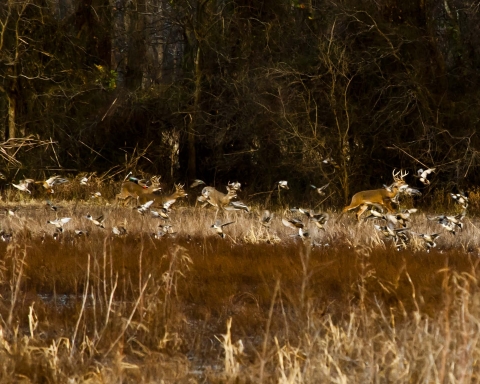About Us
Located on and around Kentucky Lake in Northwest Tennessee, the refuge’s three units, Big Sandy, Duck River, and Busseltown, stretch for 65 miles along the Tennessee River. Established in 1945, as a conservation area conservation area
A conservation area or wildlife management area is a type of national wildlife refuge that consists primarily or entirely of conservation easements on private lands. These conservation easements support private landowner efforts to protect important habitat for fish and wildlife. There are 15 conservation areas and nine wildlife management areas in the National Wildlife Refuge System.
Learn more about conservation area for migratory birds, it provides a major wintering area for migrating waterfowl. Currently the refuge habitats include agricultural crops; vegetated wetlands, mudflats, shrub/scrub areas and forested lands. This rich diversity of habitats, harbor an abundance of wildlife. Three quarters of the bird species found in this state are found on the refuge. Our checklist includes 306 birds, 51 mammals, 89 reptiles and amphibians and 144 species of fish.
Our Mission
Tennessee National Wildlife Refuge was established by Executive Order 9670 by President Harry S. Truman on December 28, 1945. The refuge was established “... as a refuge and wildlife management area wildlife management area
For practical purposes, a wildlife management area is synonymous with a national wildlife refuge or a game preserve. There are nine wildlife management areas and one game preserve in the National Wildlife Refuge System.
Learn more about wildlife management area for migratory birds and other wildlife ...”, and “... for use as an inviolate sanctuary, or for any other management purpose, for migratory birds.”, as well as “... suitable for— (1) incidental fish and wildlife-oriented recreational development, (2) the protection of natural resources, (3) the conservation of endangered species or threatened species ...”.
Our History
In 1937, a flood occurred in the Tennessee and Ohio River Valleys causing widespread devastation to communities, farms, and families. The following year, in 1938, the newly formed Tennessee Valley Authority started construction on Kentucky Dam. When the dam was completed in 1944, Kentucky Lake was born. The following year, in 1945, the Tennessee National Wildlife Refuge was established by President Harry S. Truman on the newly flooded lands and areas adjacent to the river.
Other Facilities in this Complex
Tennessee National Wildlife Refuge is managed as part of the Tennessee National Wildlife Refuge Complex.


